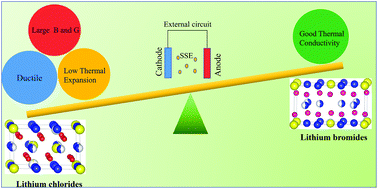Materials perspective on new lithium chlorides and bromides: insights into thermo-physical properties†
Abstract
Recently, a new class of lithium chlorides and bromides (e.g., Li3YCl6 and Li3YBr6) were reported to be promising solid-state electrolytes with high ionic conductivity in all-solid-state battery cells. However, their response under mechanical loading is not known which is critical as mechanical properties can play a pivotal role in reducing interfacing resistance between electrolytes and electrodes. To address this issue, herein, we report the thermo-physical properties of these lithium chlorides and bromides using density functional theory calculations. It was found that the new structures possess relatively larger shear moduli than those of thio-phosphate-type solid-state electrolytes and smaller Young's moduli than those of Garnet-type solid-state electrolytes. This suggests that the new halide materials can be more effective in suppressing the formation of lithium dendrites, accommodating volumetric changes of electrode materials and preventing their own degradation. Meanwhile, Poisson's ratio and Pugh's indicator calculations showed that Li3YCl6 and Li3ScCl6 possess improved ductility than other halide candidates, and thus hold promise as solid-state electrolytes. On the other hand, owing to their relatively high thermal conductivities, lithium bromides were found to be more advantageous in conducting heat which is important to ensure safety. These results provide fundamental insights into the mechanical properties of lithium chlorides and bromides and contribute to the rational mechanical design of solid-state electrolytes and the development advanced all-solid-state batteries.



 Please wait while we load your content...
Please wait while we load your content...